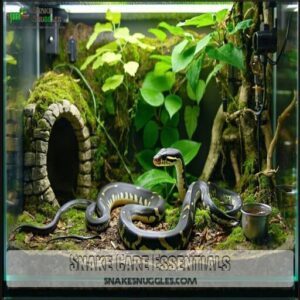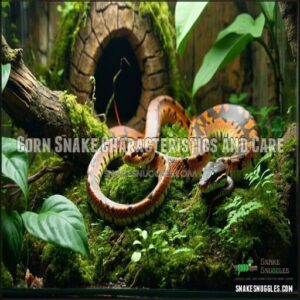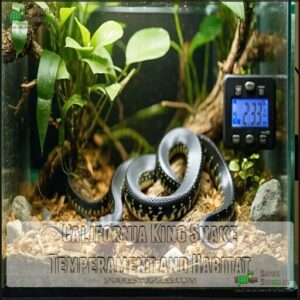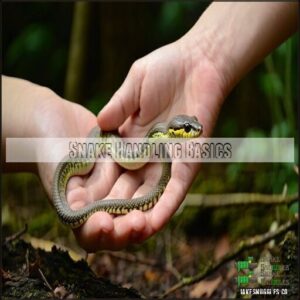This site is supported by our readers. We may earn a commission, at no cost to you, if you purchase through links.
 If you’re searching for pet snakes for beginners, a few species stand out as easy to care for and handle.
If you’re searching for pet snakes for beginners, a few species stand out as easy to care for and handle.
Corn snakes are calm, adaptable, and come in many colors. Ball pythons are another favorite—they’re gentle and thrive in simple enclosures.
California king snakes are hardy and eat well, while rosy boas stay small and require minimal upkeep.
All these snakes need a secure enclosure, proper heating, and a steady diet of frozen-thawed mice. With the right setup and care, these reptiles make fascinating pets.
Choosing the right snake is key, but understanding their needs matters just as much.
Table Of Contents
- Key Takeaways
- Choosing Pet Snakes
- Snake Care Essentials
- Popular Pet Snakes
- Creating Snake Environments
- Snake Handling Basics
- Frequently Asked Questions (FAQs)
- What is the best snake pet for a beginner?
- Do pet snakes like to be held?
- Are snakes low maintenance?
- What should be my first snake?
- What is the most cuddly pet snake?
- What should my first snake be?
- What is the best snake to have as a pet for beginners?
- What snakes don’t bite?
- Do pet snakes like to cuddle?
- What are the common health issues in pet snakes?
- Conclusion
Key Takeaways
- Pick beginner-friendly snakes like corn snakes, ball pythons, or rosy boas—they’re calm, easy to care for, and manageable in size.
- Set up a proper enclosure with secure housing, temperature gradients, and the right humidity for your snake’s species.
- Feed your snake appropriately with frozen-thawed mice, monitor its behavior, and avoid over-handling to reduce stress.
- Learn your snake’s body language to understand its needs and ensure it’s healthy with regular care and a stress-free environment.
Choosing Pet Snakes
You’ll need to pick a snake that matches your experience level and care capabilities.
Corn snakes, ball pythons, and rosy boas offer the best combination of gentle temperament and straightforward care requirements for beginners.
Corn snakes, ball pythons, and rosy boas are perfect beginner snakes with calm temperaments and easy care needs.
Researching Different Species
Before bringing a snake home, research different species thoroughly.
Start with care guides for beginner pet snakes like corn snakes, ball pythons, and rosy boas. Consider size and temperament factors when selecting a snake.
Compare their needs, temperaments, and costs on community forums. Different morphs may vary in price and care requirements.
Check breeder info for healthy specimens and avoid wild-caught snakes. Snake breeds differ in handling tolerance, feeding habits, and space needs—factors essential for new owners.
Understanding Longevity and Lifespan
Now that you know about different snake species, let’s talk about their lifespans. Pet snakes can live much longer than you might expect – between 15 to 30 years.
Consider the ongoing snake care needs before acquiring one.
- Ball pythons can reach 30+ years with proper care
- Corn snakes and king snakes typically live 15-20 years
- Garter snakes have a shorter lifespan of 5-10 years
- Proper feeding substantially affects pet snake lifespan
- Regular vet checkups help prevent common health issues
Choose a snake that fits your long-term commitment.
Considering Location and Laws
Laws for pet snakes vary widely. Some states ban snakes completely, while others have no rules at all.
Before getting your first snake, check:
- Local regulations in your city and county
- State exotic laws for non-venomous species
- Snake permits that might be required
- Rental agreements that may restrict pets
- Zoning laws in your area
You’ll need liability insurance too. Don’t skip this step—it can save you legal trouble later. Understanding snake laws is essential for responsible pet ownership. This step is crucial for avoiding potential issues.
Snake Care Essentials
You’ll need basic supplies for your snake to keep it healthy and happy.
These include a secure enclosure with proper heating, clean water, suitable substrate, and the right food for your specific species.
Snake Anatomy and Physiology
Now that you’ve chosen a snake, understanding their body is your next step. Snake physiology is simple yet fascinating.
- Overlapping scales that protect and help them move
- Forked tongues that "smell" the air
- Flexible skeletal system with hundreds of vertebrae
- Powerful muscles that contract in waves for movement
- Special jaws that unhinge to swallow prey whole
These snake anatomy basics will help you care for your pet better.
Feeding and Digestion in Snakes
All snakes are carnivores with different nutritional needs based on species. Most pet snakes require mice or rats as their main diet.
Snakes eat their prey whole without chewing. Your pet snake’s digestive process begins in the stomach and finishes in the small intestine.
Young snakes need feeding every 2-3 days, while adult snakes eat less often. Always provide fresh water.
Understanding Snake Body Language and Behavior
Reading your pet snake’s body language helps you know when they’re stressed or content. Learning to interpret snake body language is vital for responsible ownership. Snake personalities vary widely based on species and individual temperament.
After feeding, pay attention to your snake’s posture and behavior to confirm proper digestion. Watch for these body signals:
- Coiled S-shape with raised head indicates defensive behavior
- Relaxed, slow movements show comfort
- Rapid tongue flicking suggests curiosity or exploration
Providing a Suitable Environment for Snakes
To keep your snake healthy, focus on proper reptile husbandry. Choose an enclosure size based on the species.
When designing the space, consider snake enclosure options that meet the specific needs of your species. Organized snake habitats create a stress-free environment.
Provide temperature gradients, ensuring a warm and cool side. Maintain suitable humidity levels.
Use substrate types like aspen or cypress mulch and add hiding places for comfort.
Popular Pet Snakes
If you’re new to pet snakes, some species stand out as excellent choices for beginners.
These easy to care for snakes are friendly and require simple setups that won’t overwhelm you.
Corn Snake Characteristics and Care
Corn snakes are among the best snakes for beginners, thanks to their calm demeanor and easy care.
Corn snakes offer calm temperaments and simple care, making them perfect for beginner snake enthusiasts and first-time reptile owners.
They grow 3-5 feet long and thrive in a secure, well-ventilated snake habitat.
Follow these pet care tips:
- Feed frozen-thawed rodents weekly.
- Provide hiding spots for comfort.
- Maintain 75-85°F temperature.
- Verify proper humidity for shedding.
- Regularly clean the enclosure to ensure a healthy environment for your pet.
By following these simple care instructions and providing a suitable snake habitat, you can create a happy and thriving home for your corn snake.
California King Snake Temperament and Habitat
California kingsnakes are top choices for beginner pet snakes.
Known for their calm temperament, these adaptable snakes thrive in diverse habitats.
Your habitat setup should include 80-84°F temperatures and 35-60% humidity.
Easy to handle, they rarely display aggression when cared for properly, and a strong feeding response simplifies pet snake care, making them one of the best snakes for beginners.
Ball Python Requirements and Morph Variety
Ball pythons are one of the best snakes for beginners. Their docile nature and manageable size make them perfect starter pets.
In python care, you’ll need to:
- Provide a secure habitat with proper heat and humidity.
- Follow a snake feeding schedule every 7–14 days.
- Choose healthy ball python morphs responsibly.
- Monitor morph genetics to avoid health issues, which is a critical part of ensuring the snake’s well-being.
Rosy Boa Care and Feeding Requirements
Rosy boas are great beginner snakes known for their gentle nature and easy care.
Their diet includes appropriately sized mice, fed every 10–14 days for adults. A warm boa habitat with temperature gradients supports digestion and health.
Make certain Snake Nutrition stays balanced with clean water offered occasionally. Follow a feeding schedule matching seasonal needs, mimicking natural patterns for better Boa Health.
Understanding proper care schedules is vital for maintaining their overall well-being.
Creating Snake Environments
You need to create a safe, comfortable habitat to keep your snake healthy and stress-free. Focus on choosing the right enclosure, temperature, humidity, and accessories for their specific needs.
Enclosure Size and Type for Different Species
What’s the best enclosure for your snake species? Snake habitat needs vary!
Corn snakes thrive in 20-gallon tanks, while ball pythons require at least 36”x18” tanks as adults. Finding the right tank size by species is vital for their well-being.
Choose secure enclosure materials like glass or PVC for durability and ventilation systems. Confirm tank size matches your snake’s length for comfort. Good pet snake supplies include hides, enrichment, and humidity control.
Temperature Gradients and Heating Options
A thermal gradient is vital for keeping your snake healthy.
Set up a basking spot using heat lamps or mats, reaching 85-110°F, and a cooler zone for temperature control. Heating mats work well for smaller enclosures, while heat lamps suit larger setups.
Monitoring heat sources guarantees proper snake husbandry. Always include thermal gradients for effective pet snake care.
Proper heat lamp systems require understanding of heat lamp safety to prevent overheating, ensuring proper snake husbandry.
Humidity and Lighting Requirements for Snakes
Temperature control and humidity levels go hand-in-hand for snake husbandry.
Most pet snakes thrive with 40–60% humidity, adjusted during shedding.
Use a hygrometer to monitor levels and mist if needed.
Lighting options like full-spectrum bulbs enhance snake visibility but aren’t always required.
Stick to a day-night cycle for environmental balance.
This pet snake information guarantees proper reptile care for beginners, focusing on the importance of humidity levels.
Substrate Options and Accessory Recommendations
Choosing the right substrate types is essential for your snake’s health. Aspen shavings or coconut fiber work well for humidity control.
Add tank decor like hide boxes, logs, and artificial plants for comfort. Don’t forget heating options and water bowls to maintain proper temperature and hydration.
These pet snake tips are key in any beginner pet guide for easy care pet snakes. Understanding proper snake substrate selection is essential for a healthy environment and easy care.
Snake Handling Basics
Handling your snake regularly helps it feel safe and comfortable around you. Start slowly, using calm movements to build trust and avoid stress.
Getting Started With Snake Handling
Starting snake handling can feel tricky, but consistency helps.
Follow these steps for a safe experience:
- Wash Hands: Remove scents and guarantee safety.
- Approach Calmly: Avoid sudden or loud movements.
- Use a Gentle Touch: Support the snake’s body securely.
- Limit Initial Sessions: Gradually increase duration.
- Observe Behavior: Learn cues to prevent stress.
Master these basics confidently!
Building Trust and Establishing a Bond With Your Snake
Building trust with your snake takes time and patience. Gentle handling is key to creating a bond. Always use a calm approach to help your snake feel safe. Understanding your snake’s behavior is essential for nurturing a connection.
Step Action
Recognizing Snake Behavior and Body Language
Understanding pet snake behavior helps with beginner pet care.
Watch for snake posture—tight coils signal defensiveness, while relaxed body language shows calmness.
Tail vibrations or sudden movements can indicate stress signals.
Eye contact often shows curiosity, not aggression.
Feeding cues, like tongue flicking or hunting movements, suggest hunger.
Recognizing snake behaviors confirms better snake identification and builds trust in your pet snake care guide, using key observations to inform your approach.
Handling Techniques for Different Species
Handling frequency depends on species temperament.
For docile pet snakes like corn snakes or ball pythons, gentle daily handling helps them stay friendly.
Always support their body, avoiding sudden movements.
During shedding, avoid handling to reduce stress and injury risks.
Size considerations matter—larger beginner snakes need firm yet calm handholds.
Best snakes for beginners thrive with consistent, safe handling in a calm setting.
Common Handling Mistakes to Avoid
When handling beginner snakes, avoid squeezing or grabbing suddenly—these handling errors can cause snake stress or even defensive bites.
Over-handling is another mistake; snakes need calm, quiet time.
Always provide proper support for their body to keep them secure, and follow these safety precautions to build trust with your pet snake, ensuring snake ownership remains enjoyable and safe for everyone involved, which is crucial for a positive pet experience.
Frequently Asked Questions (FAQs)
What is the best snake pet for a beginner?
Corn snakes are the best choice for beginners.
They’re easy to care for, gentle, and come in vibrant colors.
They stay manageable at 3-5 feet, are hardy, and thrive with simple enclosures and feeding routines, making them a great option because they are easy to care for.
Do pet snakes like to be held?
Think of snakes like introverted roommates—they won’t crave holding but can tolerate gentle handling if done right.
Regular, calm handling helps them stay comfortable around you, but too much can cause stress.
Respect their limits.
Are snakes low maintenance?
Snakes are mostly low maintenance, needing proper enclosures, temperature control, and weekly feeding.
They don’t demand attention like other pets but require consistent care.
If you’re committed, they’re easier to manage than you’d expect, making them a good choice for those who understand the importance of proper care.
What should be my first snake?
Your first snake should be easy to care for and handle.
Corn snakes, ball pythons, or rosy boas are great choices.
They’re gentle, manageable in size, and don’t require complex setups—perfect for beginners.
What is the most cuddly pet snake?
You mightn’t associate snakes with cuddling, but ball pythons come closest.
They’re calm, enjoy curling up around your arm, and rarely act defensive, making them feel surprisingly comforting for a reptile companion.
What should my first snake be?
A corn snake is a great first choice.
It’s calm, easy to handle, and low-maintenance.
With a manageable size of 3-5 feet and minimal care needs, it’s perfect for beginners.
What is the best snake to have as a pet for beginners?
For beginners, a ball python or corn snake is ideal.
They’re manageable in size, easy to handle, and have simple care needs.
Both are calm, making them perfect for anyone new to pet snakes.
What snakes don’t bite?
No snake is guaranteed not to bite, but calm species like ball pythons, rosy boas, and corn snakes rarely do.
Handling snakes gently and reducing stress helps you avoid bites and build trust.
Do pet snakes like to cuddle?
Pet snakes don’t cuddle like dogs or cats, but some species enjoy gentle handling and warmth from your hands.
They may coil around you to feel secure, but it’s not an affectionate behavior.
What are the common health issues in pet snakes?
Think of health issues like unexpected hurdles; they include respiratory infections, mites, parasites, and digestion problems.
Regular vet visits, proper humidity, and monitoring behaviors guarantee your snake stays healthy and slithers happily through life, with regular visits being crucial for maintaining its well-being.
Conclusion
Starting your journey with pet snakes for beginners is like opening a window to a fascinating world.
With species like corn snakes, ball pythons, and rosy boas, you’ve got easy-to-care-for options that fit varied lifestyles.
Focus on their enclosures, heating, and feeding needs to keep them healthy and happy.
Researching their behavior and body language will build trust and guarantee safety.
Choose wisely, and you’ll have a low-maintenance, rewarding companion for years to come.
- https://www.petmd.com/reptile/corn-snake-care-sheet
- https://www.reddit.com/r/snakes/comments/txyzvv/best_pet_snake_for_a_beginner/
- https://a-z-animals.com/animals/snake/snake-facts/pet-snakes-cost/
- https://snakesnuggles.com/snake-feeding-guide-for-beginners/
- https://www.cloudflare.com/5xx-error-landing?utm_source=errorcode_520&utm_campaign=www.everythingreptiles.com

















